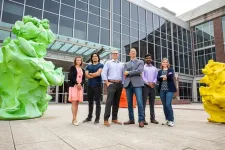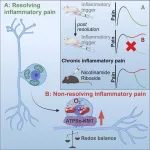(Press-News.org) CHAMPAIGN, Ill. — A new antifungal molecule, devised by tweaking the structure of prominent antifungal drug Amphotericin B, has the potential to harness the drug’s power against fungal infections while doing away with its toxicity, researchers at the University of Illinois Urbana-Champaign and collaborators at the University of Wisconsin-Madison report in the journal Nature.
Amphotericin B, a naturally occurring small molecule produced by bacteria, is a drug used as a last resort to treat fungal infections. While AmB excels at killing fungi, it is reserved as a last line of defense because it also is toxic to the human patient – particularly the kidneys.
“Fungal infections are a public health crisis that is only getting worse. And they have the potential, unfortunately, of breaking out and having an exponential impact, kind of like COVID-19 did. So let’s take one of the powerful tools that nature developed to combat fungi and turn it into a powerful ally,” said research leader Dr. Martin D. Burke, an Illinois professor of chemistry, a professor in the Carle Illinois College of Medicine and also a medical doctor.
“This work is a demonstration that, by going deep into the fundamental science, you can take a billion-year head start from nature and turn it into something that hopefully is going to have a big impact on human health,” Burke said.
Burke’s group has spent years exploring AmB in hopes of making a derivative that can kill fungi without harm to humans. In previous studies, they developed and leveraged a building block-based approach to molecular synthesis and teamed up with a group specializing in molecular imaging tools called solid-state nuclear magnetic resonance, led by professor Chad Rienstra at the University of Wisconsin-Madison. Together, the teams uncovered the mechanism of the drug: AmB kills fungi by acting like a sponge to extract ergosterol from fungal cells.
In the new work, Burke’s group worked again with Rienstra’s group to find that AmB similarly kills human kidney cells by extracting cholesterol, the most common sterol in people. The researchers also resolved the atomic-level structure of AmB sponges when bound to both ergosterol and to cholesterol.
“The atomic resolution models were really the key to zoom in and identify these very subtle differences in binding interactions between AmB and each of these sterols,” said Illinois graduate student Corinne Soutar, a co-first author of the paper.
“Using this structural information along with functional and computational studies, we achieved a significant breakthrough in understanding how AmB functions as a potent fungicidal drug,” Rienstra said. “This provided the insights to modify AmB and tune its binding properties, reducing its interaction with cholesterol and thereby reducing the toxicity.”
Armed with the information from the NMR studies, the Illinois team began synthesizing and testing derivatives with slight changes to the region that binds to ergosterol and cholesterol, while also boosting the kinetics of the ergosterol-removing process to maintain efficacy.
Enabled by collaborators and facilities at the Carl R. Woese Institute of Genomic Biology and U. of I. veterinary clinical medicine professor Dr. Timothy Fan, the researchers tested the most promising derivatives – first with in vitro assays, quickly assessing the efficacy in killing fungi; then moving to cell cultures and eventually live mice, assessing toxicity.
One molecule, dubbed AM-2-19, stood out from the rest.
“This molecule is kidney-sparing, it is resistance evasive and it has broad spectrum efficacy,” said postdoctoral researcher Arun Maji, a co-first author of the paper. “We tested this molecule against over 500 different clinically relevant pathogen species in four different locations. And this molecule completely surprised us by either mimicking or surpassing the efficacy of current clinically available antifungal drugs.”
The researchers tested AM-2-19 in human blood and kidney cells to screen for toxicity. They also tested AM-2-19 in mouse models of three common, stubborn fungal infections and saw high efficacy.
“During my medical rotations, we called AmB ‘ampho-terrible,’ because of how hard it was on patients,” Burke said. “Decoupling the efficacy from the toxicity turns ‘ampho-terrible’ into ‘ampho-terrific.’ We are very excited about the potential we are seeing, although clinical study is needed to see if this potential translates to people.”
As a first step toward clinical application, AM-2-19 has been licensed to Sfunga Therapeutics and recently entered Phase 1 clinical trials. Sfunga Therapeutics also supported the work in part, and Burke received consulting income and equity in the company.
The National Institutes of Health supported this work. Illinois chemistry professor Taras Pogorelov also was a coauthor of the work under grants 5R01-AI135812-04, R35-GM118185, R01-GM112845 and R01-GM123455, R01-AI063503 and P41-GM136463. Fan also is affiliated with the Carle Illinois College of Medicine and the Cancer Center at Illinois. Burke and Pogorelov are affiliated with the Beckman Institute for Advanced Science and Technology.
END
New antifungal molecule kills fungi without toxicity in human cells, mice
2023-11-08
ELSE PRESS RELEASES FROM THIS DATE:
Cellular “atlas” built to guide precision medicine treatment of rheumatoid arthritis
2023-11-08
Research consortium investigators analyzed over 314,000 cells from rheumatoid arthritis tissue, defining six types of inflammation involving diverse cell types and disease pathways
Understanding the disease at single-cell level may advance targeted drug development and treatment strategies
Rheumatoid arthritis (RA) is an autoimmune disease characterized by inflammation that leads to pain, joint damage, and disability, which affects approximately 18 million people worldwide. While RA therapies targeted to specific inflammatory pathways have emerged, only some patients’ symptoms improve with treatment, emphasizing the need for multiple ...
Estimated effectiveness of co-administration of the Pfizer-BioNTech COVID-19 vaccine with influenza vaccine
2023-11-08
About The Study: In this study that included 3.4 million adults, co-administration of the BNT162b2 BA.4/5 bivalent mRNA COVID-19 vaccine (Pfizer-BioNTech) and seasonal influenza vaccine was associated with generally similar effectiveness in the community setting against COVID-19–related and seasonal influenza vaccine-related outcomes compared with giving each vaccine alone and may help improve uptake of both vaccines.
Authors: Leah J. McGrath, Ph.D., of Pfizer Inc., in New York, is the corresponding author.
To ...
Age at diagnosis of atrial fibrillation and incident dementia
2023-11-08
About The Study: Earlier onset of atrial fibrillation was associated with an elevated risk of subsequent all-cause dementia, Alzheimer disease, and vascular dementia in this study including 433,000 UK Biobank participants, highlighting the importance of monitoring cognitive function among patients with atrial fibrillation, especially those younger than 65 years at diagnosis.
Authors: Fanfan Zheng, Ph.D., of the Chinese Academy of Medical Sciences & Peking Union Medical College in Beijing, and Wuxiang Xie, Ph.D., of the Peking University First ...
Physicists trap electrons in a 3D crystal for the first time
2023-11-08
Electrons move through a conducting material like commuters at the height of Manhattan rush hour. The charged particles may jostle and bump against each other, but for the most part they’re unconcerned with other electrons as they hurtle forward, each with their own energy.
But when a material’s electrons are trapped together, they can settle into the exact same energy state and start to behave as one. This collective, zombie-like state is what’s known in physics as an electronic “flat band,” and scientists predict that when electrons are in this state they can start to ...
Scaling up nano for sustainable manufacturing
2023-11-08
A new self-assembling nanosheet could radically accelerate the development of functional and sustainable nanomaterials for electronics, energy storage, health and safety, and more.
Developed by a team led by Lawrence Berkeley National Laboratory (Berkeley Lab), the new self-assembling nanosheet could significantly extend the shelf life of consumer products. And because the new material is recyclable, it could also enable a sustainable manufacturing approach that keeps single-use packaging and electronics out of landfills.
The ...
Validating the role of inhibitory interneurons in memory
2023-11-08
Memory, a fundamental tool for our survival, is closely linked with how we encode, recall, and respond to external stimuli. Over the past decade, extensive research has focused on memory-encoding cells, known as engram cells, and their synaptic connections. Most of this research has centered on excitatory neurons and the neurotransmitter glutamate, emphasizing their interaction between specific brain regions.
To expand the understanding of memory, a research team led by KAANG Bong-Kiun (Seoul National University, Institute ...
Scientists tame biological trigger of deadly Huntington’s disease
2023-11-08
Huntington’s disease causes involuntary movements and dementia, has no cure, and is fatal. For the first time, UC Riverside scientists have shown they can slow its progression in flies and worms, opening the door to human treatments.
Key to understanding these advancements is the way that genetic information in cells is converted from DNA into RNA, and then into proteins. DNA is composed of chemicals called nucleotides: adenine (A), thymine (T), guanine (G), and cytosine (C). The order of these nucleotides determines what biological instructions are contained in a strand of DNA.
On occasion, some DNA nucleotides repeat themselves, ...
Disturbances in sensory neurons may alter transient pain into chronic pain
2023-11-08
Utrecht, November 8, 2023 - Researchers from the Center for Translational Immunology at University Medical Center Utrecht (the Netherlands) have identified that a transient inflammatory pain causes mitochondrial and redox changes in sensory neurons that persist beyond pain resolution. These changes appear to predispose to a failure in resolution of pain caused by a subsequent inflammation. Additionally, targeting the cellular redox balance prevents and treats chronic inflammatory pain in rodents.
Pain often persists in patients with an ...
SMU Lyle nanorobotics professor awarded prestigious research grant to make gene therapy safer
2023-11-08
DALLAS (SMU) – SMU nanotechnology expert MinJun Kim and his team have been awarded a $1.8 million, R01 grant from the National Institutes of Health (NIH) for research related to gene therapy – a technique that modifies a person’s genes to treat or cure disease.
NIH R01 (Research Program) grants are extremely competitive, with fewer than 10 percent of applicants receiving one.
The four-year grant will allow Kim, the Robert C. Womack Chair in the Lyle School of Engineering at SMU (Southern Methodist University) and principal investigator ...
$200M gift propels scientific research in the search for life beyond earth
2023-11-08
$200m Gift Propels Scientific Research in the Search for Life Beyond Earth
Legacy of Franklin Antonio represents quantum leap for The SETI Institute
November 8, 2023, Mountain View, CA – The SETI Institute, a non-profit scientific research organization, announced today a philanthropic gift of $200m from the estate of Franklin Antonio, a visionary supporter and catalyst of the work of the SETI Institute for more than 12 years. Co-founder of communications chip company, Qualcomm, Antonio passed away on May 13, 2022, leaving behind an extraordinary ...









